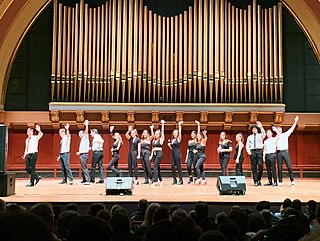
Music performed a cappella, less commonly spelled a capella in English, is music performed by a singer or a singing group without instrumental accompaniment. The term a cappella was originally intended to differentiate between Renaissance polyphony and Baroque concertato musical styles. In the 19th century, a renewed interest in Renaissance polyphony, coupled with an ignorance of the fact that vocal parts were often doubled by instrumentalists, led to the term coming to mean unaccompanied vocal music. The term is also used, rarely, as a synonym for alla breve.
The Hangovers are a men's collegiate a cappella ensemble based at Cornell University. Founded in 1968, they are the oldest active a cappella group on campus and are the official a cappella subset of the Cornell University Glee Club, itself the oldest student organization of any kind at Cornell University. The Hangovers' repertoire consists mainly of popular songs arranged for the ensemble by its members and alumni, but the group also performs traditional Cornell songs, as well as selections from the Glee Club repertoire on occasion.

Deke Sharon is an American singer, arranger, composer, director, producer, author, coach, pioneer, and teacher of a cappella music, and is one of the leaders and promoters of the contemporary a cappella community. He has been referred to as "the father of contemporary a cappella" and "the godfather of a cappella".
The International Championship of Collegiate A Cappella (ICCA), originally the National Championship of Collegiate A Cappella, is an international competition run by Varsity Vocals, that attracts hundreds of college a cappella groups each year.

Doox of Yale are an all-gender undergraduate a cappella group at Yale University. The group was founded by first-year students in 1952, and in 2017, was the first TTBB a cappella group in the 21st century at Yale to become all-gender.

BYU Vocal Point, or simply Vocal Point, is a seven to nine-member, male a cappella group at Brigham Young University (BYU). Founded by two students, Bob Ahlander & Dave Boyce, in 1991, Vocal Point is under the direction of former member Carson Trautman.

The Stanford Mendicants are an all-male a cappella group at Stanford University. The group is Stanford University's first a cappella group. Since its founding in 1963, the group's size has varied from 6 to 19 members. Although they are strictly an a cappella group today, they have performed with instruments in previous generations. The group prides itself on singing a wide range of songs, from gospel to barbershop to pop tunes and original compositions. The Mendicants are known around Stanford's campus for their red blazers and romantic serenades.

Voices in Your Head is a student-run a cappella group from the University of Chicago who aim to "push the bounds of contemporary a cappella." Founded in 1998, the group has consisted of both undergraduate and graduate students whose studies range from Economics to Music to MD/PhD programs. Its unique repertoire includes original pieces, as well as an eclectic mix of pop, R&B, rock, and alternative music. Voices competes regularly in the International Championship of Collegiate A Cappella (ICCA) and releases studio recordings of their arrangements.

The Stanford Harmonics are a co-ed a cappella group from Stanford University. Known for their alternative rock repertoire and award-winning recordings, the Harmonics have garnered international recognition for their performances and have been featured on BOCA, Sing, and Voices Only a cappella compilations. The Harmonics are one of the few collegiate a cappella groups that own their own wireless microphone equipment and have developed a live performance style that includes the use of electronic distortion and sound effects.
The Accidentals are an all-male collegiate a cappella group. Formed in 1974, the Accidentals are the oldest a cappella group at the University of Georgia. The Accidentals are typically anywhere from 12 to 17 members and hold auditions every fall and occasionally at the end of the spring

The Brown Derbies is an a cappella group at Brown University. They were founded by Darryl Shrock in 1982 and have released fourteen albums. They sing a variety of different genres, ranging from Rock, to Pop, to R&B and are known in the a cappella community for their unique use of syllables in the background vocals. They have toured throughout the United States and internationally, with recent performances in Beijing, China, Shanghai, China, and New Orleans, Louisiana. In 1997, the group performed for President Bill Clinton at the White House. In November 2007, they were featured on the CBS Early Show in a segment about the rising popularity of a cappella groups on college campuses, and in July 2011 they were featured on the Gospel Music Channel reality show America Sings. In January 2012, they performed in the London A Cappella Festival.

The Compulsive Lyres is an a cappella group at the University of Michigan. The group includes both music and non-music majors and sings various arrangements of pop, rock, and R&B songs.

The Yale Alley Cats is an undergraduate a cappella singing group at Yale University, the college's third-oldest.

BYU Noteworthy is a seven to nine-member, female Brigham Young University (BYU) a cappella group, based in Provo, Utah, United States. They won 1st place at the International Championship of Collegiate A Cappella (ICCA) in 2007 and appeared on the first season of NBC's a cappella competition reality show The Sing-Off in 2009. Esther Yoder formed the group in 2003, aided by members of BYU's Vocal Point. Noteworthy began operating under the direction of the Performing Arts Management (PAM) at BYU in 2014. One of their most popular music videos is a cover of Amazing Grace, which won the Contemporary A Cappella Society (CARA) award for Best Religious Video and has garnered millions of views on YouTube since its release. Noteworthy has released six albums since its formation in 2003. In 2018, Noteworthy performed "Come Thou Fount of Every Blessing" for a Mormon Message for the Church of Jesus Christ of Latter-day Saints.
Another Round, formerly Straight No Chaser, is a collegiate a cappella group which originated in 1996 at Indiana University. The group changed its name several years after the original members reformed as a professional group with the same name.
The Northwestern Undertones are a 20-member co-ed collegiate a cappella group from Northwestern University in Evanston. Founded in 2001 by Jeni Noerenberg, the group was originally called Something Old, Something NU, but the name changed within a year.

Out of the Blue is a co-ed a cappella group from Yale University. Out of the Blue's repertoire includes music that spans 50 years and several genres, including pop, folk, and R&B. The group has won multiple a cappella competitions, awards, and accolades, shared the stage with Ben Folds and Sister Hazel, and performed for audiences all over the world. Out of the Blue records a full-length studio album every two years. The group's seventeeth studio album, In My Bed, was released in August 2024.

Semi-Toned is a British all-male A cappella group from the University of Exeter, in the United Kingdom who sing a variety of modern and classic songs. They were formed in October 2010 originally as a barbershop quintet, before establishing themselves as a twelve-man contemporary group with a wide range of repertoire dedicated to developing their musical abilities whilst sharing a passion for singing and performing. They became more well known after multiple TV and radio appearances on shows such as 'The Choir: Gareth's Best in Britain' (BBC2) and 'Sing: Ultimate A Cappella', as well as singing on BBC Radio 2 with Rylan Clarke-Neal during his 'Great Ka-Ry-oke Challenge' in support of BBC Children in Need 2019. They now regularly tour both the UK and US, as well as performing annually at the Edinburgh Fringe Festival and frequently releasing albums and music videos.

The CU Buffoons is the oldest collegiate a cappella group at the University of Colorado-Boulder, founded in 1962 by Dr. Oakleigh Thorne II with help from Don Grusin and Roger Nelson. The group has consisted of anywhere from 8-20 undergraduate and graduate students throughout its over 60-year history, with new members being auditioned at the start of every fall semester. With arranging being done in house by current and former group members, their repertoire consists of covers of pieces from a wide variety of musical genres, including jazz, rock, RnB, pop, show tunes, and more, and is constantly updated with new arrangements of more recent songs.
















